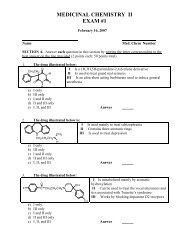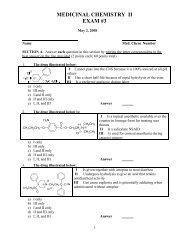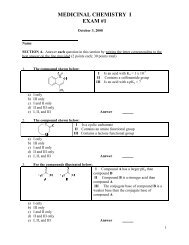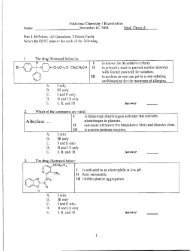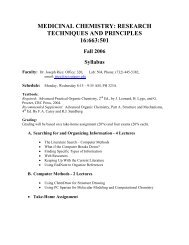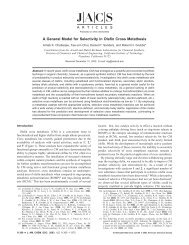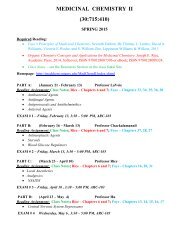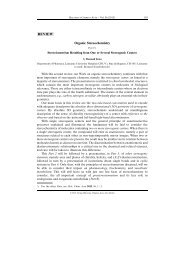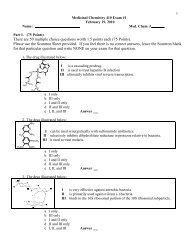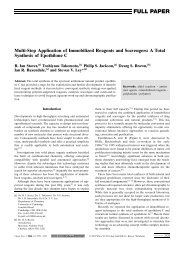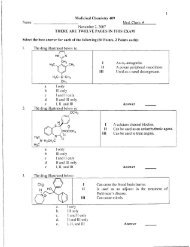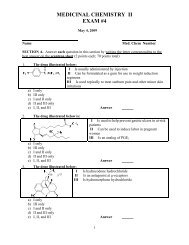Baldwin's Rules - Department of Medicinal Chemistry
Baldwin's Rules - Department of Medicinal Chemistry
Baldwin's Rules - Department of Medicinal Chemistry
You also want an ePaper? Increase the reach of your titles
YUMPU automatically turns print PDFs into web optimized ePapers that Google loves.
Chemical Reviews REVIEW<br />
products. 133 In a similar way, conjugation with a β-pyridine moiety<br />
does not affect the exocyclic regioselectivity either (Scheme 34). 134<br />
Because <strong>of</strong> the stereoelectronic features <strong>of</strong> the alkyne moiety, the<br />
incipient radical in these two examples remains orthogonal to the<br />
internal π-systems in the transition state and, thus, the 6-endo-dig<br />
closure does not receive any conjugative assistance.<br />
Scheme 33. Regioselective 5-exo-dig Cyclizations <strong>of</strong><br />
Benzylic Radical<br />
Scheme 34. Regioselective 5-exo-dig Cyclizations <strong>of</strong> Internal<br />
Alkynes with Acyclic Carbon Radicals<br />
As with the smaller rings (4-exo/5-endo cyclizations, Table 10), 83<br />
the closures <strong>of</strong> sp 2 -hybridized radicals (motifs B, C) have lower<br />
activation barriers due the higher exothemicity <strong>of</strong> the conjugated<br />
products formation (Table 20) relative to the parent systems<br />
(Table 18). However, while the exo/endo barriers are close for<br />
4-exo/5-endo pair, a clear stereoelectronic 5-exo preference is<br />
observed for σ-vinylexo and σ-vinylendo closures, despite these<br />
processes being less exothermic than their 6-endo counterparts.<br />
135 The slight differences observed for motifs B and C<br />
are due to the greater stability <strong>of</strong> endocyclic alkenes and<br />
trans-dienes relative to exocyclic alkenes and cis-dienes 136<br />
(Table 20).<br />
The 5-exo barriers are relatively insensitive to structural<br />
changes (Table 20, entries 1, 3, 5), while the 6-endo barriers<br />
vary significantly. As the result, the kinetic preference for the<br />
formation <strong>of</strong> 5-exo products significantly decreases in motif B<br />
compared to motif C. It is interesting that the intrinsic barriers for<br />
both the 5-(σ-vinylendo)-exo and 6-(σ-vinylendo)-endo cyclizations<br />
(motif C) are ∼2 kcal/mol higher than for the respective<br />
“σ-vinylexo” cyclizations. Although these differences are consistent<br />
with the orientation <strong>of</strong> radical orbitals in the two reagents<br />
(the radical orbital for the σ-vinylexo radical is tilted outward,<br />
which should facilitate attack at the alkyne’s terminal carbon,<br />
see red arrows in Table 20), it is not clear whether this is a<br />
determining factor. Because <strong>of</strong> the unfavorable orientation <strong>of</strong> the<br />
radical orbital in the reactant, locking the reacting vinyl group in a<br />
benzene ring (motif C) leads to a further increase in the 6-endo<br />
barrier.<br />
Starting from the vinyl bromide (motif B), Montevicchi<br />
and co-workers found that, as with the other cyclizations<br />
Table 20. Activation Barriers, Reaction Energies, and<br />
Intrinsic Barriers (kcal/mol) for 5-exo-dig and 6-endo-dig<br />
Cyclizations <strong>of</strong> sp 2 -Radicals with a Saturated Bridge<br />
between the Vinyl and a Terminal Alkyne Moieties<br />
(B3LYP/6-31G** Level) a<br />
a Arrows overlaid with the SOMOs <strong>of</strong> parent vinyl radicals (motif B, C)<br />
show projection <strong>of</strong> the radical orbital in space. 135 Ring-closing bonds are<br />
shown in red.<br />
Scheme 35. Regioselective 5-(σ-Vinylexo)-exo-dig Cyclizations<br />
<strong>of</strong> Carbon-Centered Radicals<br />
discussed in this section, TMS-substitution facilitates regioselective<br />
5-exo attack (54% yield, Scheme 35). 137 Journet and<br />
Malacria published an efficient cascade initiated by a similar<br />
regioselective closure onto an alkyl-substituted triple bond<br />
(Scheme 35). 138<br />
Sha and co-workers have found that both R-andβ-vinyl radicals<br />
(motif C) in an enone system undergo clean 5-(σ-vinylendo)exo-dig<br />
cyclizations onto TMS-substituted alkynes. Both [4.3.0] and<br />
[3.3.0]-bicyclic ring systems, as well as heterocycles, are formed in<br />
70 89% yields (Scheme 36). 139 It is noteworthy that in the second<br />
example, even when n = 1, the cyclization is regioselective for<br />
exocyclic closure onto the TMS substituted alkyne, forming the<br />
5 5 bicyclic system (Scheme 36). 140<br />
Five-membered heterocycles can also be efficiently and regioselectively<br />
synthesized using aryl radicals (motif C, Scheme 37). 141<br />
The experimental data are in good agreement with the DFT analysis<br />
W dx.doi.org/10.1021/cr200164y |Chem. Rev. XXXX, XXX, 000–000



